Beowulf
 |
 |
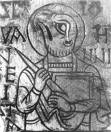 |
 |
 |
Beowulf is the first great heroic poem in English literature. It is an Anglo-Saxon poem transcribed by an unknown author in Old English (aka. Anglo-Saxon); Beowulf has been characterized as an elegy but it also resembles a heroic epic though it is smaller in scope than most heroic epics. Also, it is characterized as an encomium – a song of praise for a great king. The original poet used the oral sagas and legends of his/her ancestors as the basic material for the epic.
The only manuscript that survives today is in the British Museum and is thought to have been written down by two scribes around 1000A.D in England. The two scribes were probably Christian monks as they were the only ones who could read and write during that time period. The second of the two took over at line 1939 of Beowulf. Throughout the poem it is likely that the monks had Christianized the epic, because the Geats were pagan. The poem appears in what is today called the Beowulf manuscript or Nowell Codex (British Library MS Cotton Vitellius A.xv), along with other works.
Beowulf is significant for its place in literary history as well as its eminence as heroic poetry. Beowulf is the only full length epic extant from the Anglo-Saxon period of English literary history. While its antiquity and its ceremonial poetic style may make it less accessible to modern students, it is a poem worth reading and exploring. Beowulf is full of suspense, scenes of action, blood and gore, monsters and dragons; it features a young hero, daring and hopeful who wants to make his mark on the world. |
Setting The poem itself is set in Denmark and Geatland (area of Southern Sweden) in about the year 500 before the Germanic tribes migrated to England. While Beowulf seems to be a fictional character, some others including King Hygelac (Lord of the Geats) are historical. Hygelac, Beowulf’s uncle, was killed in a battle with the Frisians in about 516ce. |
 |
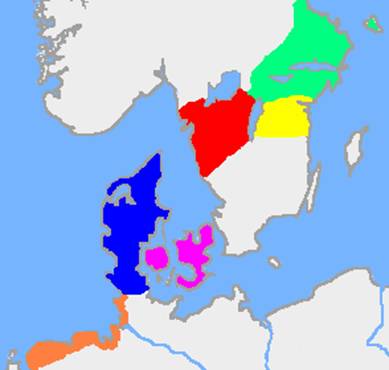 |
An approximation of the central regions of the tribes mentioned in Beowulf. The red area is Västergötland (the core region of Geatland), the yellow area is the territory ruled by the Wulfings, the pink area is the Danish territory. The green area is the land of the Swedes. For a more detailed discussion on the fragmented political situation of Scandinavia during the 6th century, see Scandza |
Structure Binary Structure J.R.R. Tolkien wrote that the structure of the poem “is essentially balance, an opposition of endings and beginnings. In simple terms, it is a contrasted description of two moments in a great life, rising and setting; an elaboration of the ancient and intensely moving contrast between youth and old age, first achievement and final death.” It is argued that Beowulf presents us with two parallel sentences but expresses no conjunction – this view is grounded upon the technique of “silent” juxtaposition. Tripartite Structure Many scholars see Beowulf as having three distinct sections which each culminate with the confrontation of the monster: Grendel, Grendel’s Mother, and the dragon. The view usually sees an increase in the significance of the hero and in the difficulty of his victories. The image here might be of a ladder or any image of linear sequence. Usually proponents of the “three act structure” see him evolving through three stages from the ideal warrior to the ideal sovereign. One could also compare and contrast the three parts of the epic poem.
Interlace Structure One of the more popular critical views today sees the art of juxtaposition in Beowulf as comparable to the intricate interlacing of zoomorphic ornaments in Anglo-Saxon art. This has been argued by John Leyerle in two innovative essays. Leyerle takes the phrase wordum wrixlan “to exchange [ or weave] words” as referring to the interlaying of narrative episodes. He suggests that the technique of variation itself could be defined as a form of interlace. This interweaving idea is well known in later French chivalric romances, where it is called entrelacement, but we have no clear evidence that it was part of Anglo-Saxon critical terminology. Of course, all the digressions, narrative episodes, lays, and the main plot would have to weave into one (or a few) major theme(s). |
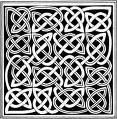 |
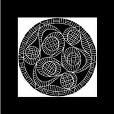 |
 |
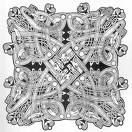 |
Magnetic Structure Another view is that everything relates to the hero and his journey. The entire structure of the poem – all of the apparently scattered materials and disconnected episodes are grouped in a wide sweep around the hero’s character. In fact they are his character; they are the comparisons and contrasts by which we may arrive at a just appreciation of his nature. This is essentially the metaphor of a magnet. The life of the hero draws many other disparate but significant stories toward it like iron fillings to a magnet. The pattern they make will be the whole subject of the poem. |
Anglo-Saxon Poetry The poet wrote Beowulf in the Old English style of accentual and alliterative verse which the Scandinavians brought with them to England. Its meter is defined by its stress patterns, not by vowel length or number of syllables. The Old English poetic line has two halves, divided by a sharp pause, or caesura. There are two beats to each half line – thus, there are four beats to the line. The alliteration of the whole line is determined by the first heavily stressed syllable of the second half-line which will alliterate with both or either of the two stresses in the first half-line. Essentially, the third stress is the key which locks the two half-lines together. The fourth stress does not usually alliterate in basic form. A varying number of unaccented syllables surrounding the stresses is permitted. Lines 4-7 of Beowulf illustrate these features . Poetic Terms The Anglo-Saxons loved to use compressed metaphors/descriptive comparisons called kennings. For example some kennings in Beowulf are “whale-road” (sea), “sail-road” (sea), “bone-chamber” (body), or “candle of heaven” (sun). Also, Beowulf uses variation which is basically a double or multiple statement of one concept or term in which each restatement suggests a new aspect, be it more general or specific. It addition to slowing the narrative pace, variation raises into high relief those aspects of the action the poet wishes to emphasize. The poet will usually break an event into separate components and present them as a series of pictures like a tapestry. This verbal splitting and recombining of ordinary perceptions to create something new is a sign of true poetry and is related to the larger cyclical structure of the poem. The Anglo-Saxon poet also used parataxis – which is the lack of subordinating conjunctions to create a forward leaning sentence –this type of sentence can tolerate an indefinite number of additions before its close. This sort of free grammatical space can be seen in lines 213-215: “they carried weapons, stored amid ships, all the bright ornaments, stately battle dress.” Or lines 226-227: “Their chain mail clanked, their bright battle shirts.” While there are many more characteristics of Anglo-Saxon poetry, one more poetic device the Beowulf poet utilizes is the litotes – a form of verbal irony used in many Old English heroic style pieces - which is a deliberate or steep understatement. The poet may use this to make sharp juxtapositions of contrasting moods, themes, or episodes to throw his own viewpoint to the foreground (This is not unlike satire which we briefly reviewed earlier). For example, lines 1506-1509: “Then the angry sea-wolf swam to the bottom, carried to her den the lord of those rings, clutched him so hard he might not draw his sword – no matter how brave.” “No matter how brave” can translate literally from the Anglo-Saxon as “he was not at all spirited about that” and we can imagine that Beowulf felt a good deal less than swell. A sharp incongruity like this can wrest a grin from us even at the direct points in the action. |
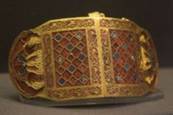 |
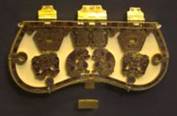 |
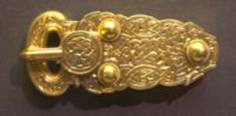 |
Elegy was originally used for a type of poetic meter (Elegiac metre), but is also used for a poem of mourning, from the Greek elegos, a reflection on the death of someone or on a sorrow generally. In addition, an elegy (sometimes spelled elegíe) may be a type of musical work, usually in a sad and somber attitude. Not to be confused with an eulogy.
Beowulf is an Epic Poem: a narrative poem that tells in an elevated style the achievements and brave deeds of heroic characters. Miraculous events and supernatural beings often play a part. The characteristics of an Epic: 1. The hero is a figure of national importance. 2. The action involves a long and dangerous journey. 3. The setting of an epic is large in scale. 4. Supernatural beings and events play a role in epic affairs. 5. The style of the of an epic is formal and grand. 6. Epics assign short phrases to individual characters. More specifically, it is a Folk Epic because it is a narrative is based on heroic legends.
Literary Terms Scops: The heroic poems were usually sung by trained singers, called scops, who sometimes composed them extemporaneously for the entertainment of the king and all his warriors at celebrations in the mead hall. The scops were much honored by the Anglo-Saxon kings and people because they were the keepers of the history and mythology of their country men since they did not read or write until they converted to Christianity in 597. A good scop spread the fame of his king by composing songs about his exploits in battle and comparing him to the ancient heroes of saga and song. Fame along transcended the limitations of time and the inevitability of death. The struggle for fame was the pathway of the hero, and his renown depended on the scop who sang of his glorious deeds.
Mead-hall: The mead hall is the central gathering place for the Anglo-Saxon Lords and his warriors. In this hall the men would eat, drink and enjoy entertainment. This is the place where the Lord would hand out generous treasures after winning a battle. |
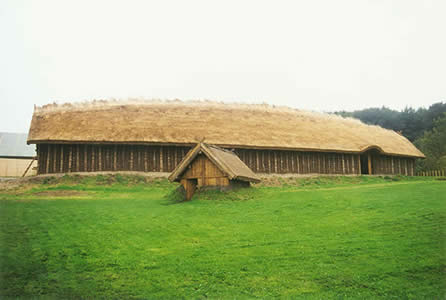 |
Sutton Hoo Sutton Hoo near Woodbridge, Suffolk, is the cite of two Anglo-Saxon Cemeteries of the 6th and early 7th centuries, one of which contained an undisturbed ship burial including a wealth of artifacts of outstanding art-historical and archaeological significance. Sutton Hoo is of primary importance to early medieval historians because it sheds light on a period of English history which is on the margin between myth, legend and historical documentation. Use of the site culminated at a time when the ruler (Raedwald) of East Anglia held senior power among the English, and played a dynamic (if ambiguous) part in the establishment of Christian rulership in England. It is central to understanding of the Anglo-Saxon Kingdom of East Anglia and of the period in a wider perspective. The ship-burial, excavated in 1939, is one of the most magnificent archaeological finds in England for its size and completeness, the far-reaching connections, quality and beauty of its contents, and for the profound interest of the burial ritual. |
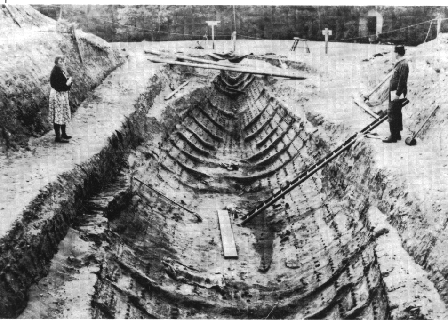 |
Some central questions for this unit: 1. What role does the mead-hall play in Anglo-Saxon Warrior Culture? What is the proper relationship between a Lord and his warriors? 2. What is the role of women in the heroic culture of Beowulf? What was their role in Anglo-Saxon society? Why is it different in the poem – what does the poem accomplish then? 3. How does treasure function in Beowulf? How do the characters and poet seem to feel about the element of gold, as it appears throughout the poem? 4. What role do the digressions (or lays) play in Beowulf? What light do they shed on the main plot, conflict, characters, themes? What artistic function do they serve? 5. What role does identity play in this epic tale? How do characters establish their identity? What role does identity play in the main plot, conflict, and themes? How is this connected to the oral tradition which pervaded this pre-literate society? 6. What is the heroic code? What is the nature of heroism in Beowulf? What other value systems emerge throughout the poem? When do they come into conflict – which wins out and why? 7. What does it mean to be a good warrior and a good king? What are the virtues of Anglo-Saxon kingship? How doest he poet explore the loyalty of kinsman and sworn followers? 8. How does the struggle for fame contribute to the poem? In examining this basic theme, how do we see the tension between the pagan and Christian ideologies? 9. How is death – mortality and immortality – portrayed in the poem? 10. What relationship do you see between the Pagan and Christian belief systems in the poem? Do they ever come into conflict? If so: Where/Why/How? 11. Is Beowulf an idea hero and king? Why or why not? Does the perspective matter? Ancient/Modern; Christian/Pagan? 12. Would you say that the characters in Beowulf are psychologically complex compared to modern works of literature? Do they undergo development as the poem progresses? 13. The Viking fascination with the sea – a fascination which continues in the consciousness of the England island nation is one thread woven throughout the poem? What ideas surround the sea – what power does it hold for these ancient warriors? |